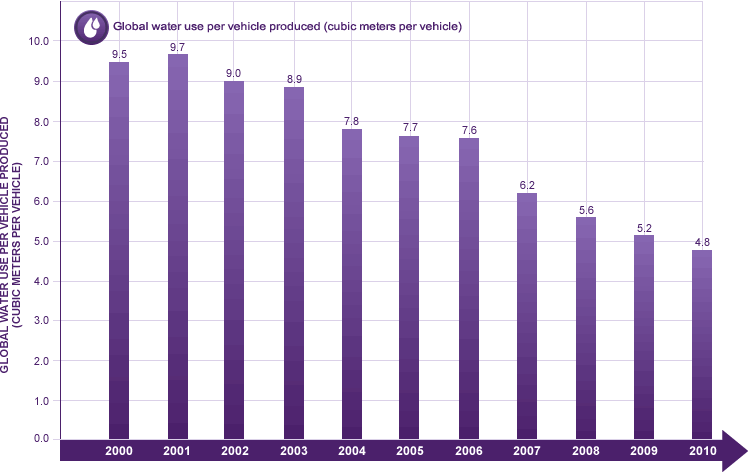Progress at Ford
More than a decade ago, Ford made a commitment to decrease our water use, setting a target of 3 percent year-over-year reductions. Since we launched our Global Water Management Initiative in 2000, we have made outstanding progress. Our global manufacturing facilities have saved approximately 10.5 billion gallons of water over the past 10 years – a 62 percent reduction. Water use per vehicle decreased by 49 percent from 2000 to 2010.
We have taken a broad range of actions that have helped us minimize our water footprint. For example, we implemented a reverse-osmosis process to recycle water in a number of our production plants, allowing us to avoid using higher-quality water suitable for human consumption. We’ve employed an innovative parts-washing system to reduce wastewater and cut energy consumption. We have also looked to new technologies, such as one that lubricates cutting tools with a fine spray of oil, rather than the conventional wet machining that previously required pumping millions of gallons of metal-working fluids and water to cool and lubricate tools.
These actions don’t attract many headlines – but they make an impact. And they reflect our commitment to reduce our environmental impacts.
For 2011, we are aiming for a global water reduction of 5 percent per vehicle compared to 2010. Moving forward, we also will be setting internal year-over-year efficiency targets as part of the annual environmental quality business planning process within each of our global regions. And we will be requiring all of our plants to perform basic, low-cost water-reduction actions.
If we want to continue to reduce our water footprint, we must implement a more global approach that cascades best practices from our own plants – and from other industries. We have been benchmarking our peers and other manufacturers to look for water-saving techniques that can be adapted to Ford locations. We will also be looking at other management techniques, such as the introduction of critical monitoring and efficiency projects, the integration of new technologies and facility upgrades, and the alignment of resources.
For more on our water-reduction efforts to date, please see the Environment section of this report.
Related Links
- This Report:

- Overview
- Economy Data
- Environment Data
- Society Data
